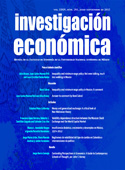MONEY AND GENERALIZED EXCHANGE: A CRITICAL LOOK AT NEO-WALRASIAN THEORY
Contenido principal del artículo
Resumen
The proof of existence of market clearing equilibrium is the cornerstone of Neo-Classical theory. While it is generally portrayed as a barter framework, the proof actually assumes an accepted system of credits and debits; a system of privately issued IOU’s, or what is the same thing commitments by private agents to deliver a certain quantity of a given commodity at a given equilibrium price. In other words, the proof presupposes the existence of ‘inside money’. Yet a system of generalized exchange with pure inside money is not compatible with the main principles of Neo-Classical monetary theory including that inflation is always and everywhere a monetary phenomenon, the exogeneity of money and also the neutrality of money. This explains the importance and necessity of introducing ‘outside money’ in general equilibrium. Focussing mainly on Patinkin’s ‘invalid dichotomy’ and the real balance effect, and to a lesser extent, on overlapping generation models, I try to show that these attempts have been unsuccessful. In both cases the integration of monetary and value theory amount to collapsing all individuals into a single one. This negates the very economic problem (i.e., multiple exchanges) that gave rise to general equilibrium theory and to the impending requirement to prove the existence of market clearing equilibrium.
Detalles del artículo
Cómo citar
Pérez Caldentey, E. (2016). MONEY AND GENERALIZED EXCHANGE: A CRITICAL LOOK AT NEO-WALRASIAN THEORY. Investigación Económica, 74(293), 39–67. https://doi.org/10.1016/j.inveco.2015.10.003
Los autores que publiquen en esta revista acceden a las siguientes condiciones:
a) Los autores retienen los derechos de copia (copyright) y ceden a la revista el derecho de primera publicación, con el trabajo asimismo bajo la licencia Creative Commons Attribution License que permite a terceros utilizar lo publicado siempre que hagan referencia al autor o autores del trabajo y a su publicación en esta revista.
b) Los autores son libres de realizar otros acuerdos contractuales para la distribución no exclusiva del artículo que publiquen en esta revista (como puede ser incluirlo en una colección institucional o publicarlo en un libro), siempre que indiquen claramente la publicación original del trabajo en esta revista.
